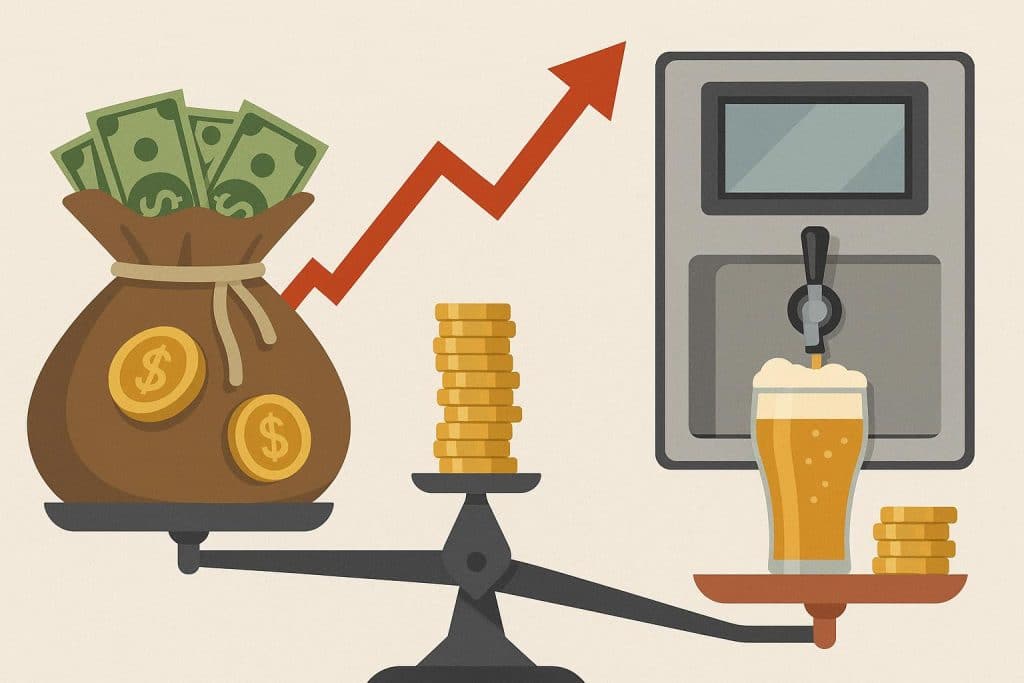Labor costs are climbing while beverage operators face tighter margins and higher guest expectations. Brewpubs, hotel bars, and stadium concessions all struggle with the same reality: too many guests, not enough staff, and rising payrolls that squeeze profit. Lines drag, service slips, and managers step in to cover shifts instead of focusing on planning and growth.
A self-pour beverage tap dispenser can change the rhythm of a busy night. Guests handle their own pours, cutting wait times and reducing strain on the floor. Staff shift from routine pouring to meaningful engagement, verifying IDs, spotting issues, and guiding tastings. Smaller crews suddenly cover bigger nights with fewer errors, cleaner data, and calmer operations—turning labor pressure into lasting efficiency.
How Staffing Strains Affect Beverage Operations
Staffing shortages ripple through every part of beverage service. Long lines at taps push guests to leave or cut visits short, draining sales momentum. Managers step into service roles to keep pace, pulling them from vendor coordination and training. When teams are stretched thin, service quality slips—refunds rise, complaints increase, and the guest experience erodes.
Pressure compounds when experienced staff are forced into reactive fixes. Rushed pours, missed modifiers, and slower table turns multiply mistakes. Recovery takes time and further delays service. The result is a cycle of fatigue and frustration that undermines both revenue and morale. Solving the strain requires reducing reliance on labor-heavy pour tasks at peak hours.
Reducing Low-Value Tasks With Self-Pour
On peak nights, self-pour taps let guests serve themselves while bartenders focus on IDs, intoxication checks, and recommendations that improve the experience. That pivot from pouring drinks to engaging guests raises satisfaction, strengthens service quality, and keeps operations steady even when fewer staff are on hand.
Smaller teams cover busier shifts because one bartender with support staff can monitor multiple kiosks. Automated pour logs simplify inventory and guide promotions that drive higher check averages. With less time lost to repetitive tasks, staff energy goes into meaningful moments—and the service floor runs with less stress and more consistency.
Financial Impact of Cutting Pour Labor
Payroll line items shrink when pour labor is reduced, cutting overtime and lowering headcount during busiest shifts. Self-pour systems recover lost sales by letting more guests sample without staff time, which raises check averages. The freed budget commonly funds targeted marketing, weekend tasting flights, or modest loyalty rewards that nudge repeat visits and higher per-guest spend.
Hardware and software costs are recouped faster when pour data guides purchasing and promos, shrinking stockouts and waste. Incremental revenue from increased sampling often shortens the payback window. Aiming for a six- to twelve-month return by rotating sample flights and tying small rewards to loyalty sign-ups works well as a next-step tactic.
Guest Experience Gains That Support Efficiency
A tasting station lined with flight glasses invites curious guests to sample without the usual wait. Giving each person control over pour size and metered increments reduces hesitation and the “one-and-done” order pattern; patrons try half-pours, compare styles, share small flights, and tipping rises with higher satisfaction while waste falls.
Multiple dispense heads across an island let several groups serve themselves at once, cutting peak queue lengths and smoothing traffic flow. Integrated pour tracking keeps tabs on tasting popularity so menus rotate more responsively and restocking needs match demand, reducing stockouts. Grouping taps by style encourages sampling and speeds choices.
Operational Efficiencies That Add Up Daily
Behind the bar, small efficiencies add up quickly. Self-pour data syncs directly with POS entries, shrinking nightly reconciliation and flagging over-pours before they eat into margins. Keg-level sensors and timestamped logs reveal when to reorder without guesswork, reducing emergency runs and last-minute stress. Inventory management shifts from reactive to predictable.
Daily pour reports highlight slow movers and best-sellers, helping managers rotate taps, refine pour sizes, and order stock that matches demand. Less waste, fewer stockouts, and tighter margins become daily habits. With the routine simplified, staff close faster, managers plan better, and every shift ends calmer.
Rising staffing costs don’t have to shrink margins or service quality. Self-pour systems rebalance labor and technology, letting smaller crews cover peak shifts while guests enjoy faster service and more control. Each pour generates data that sharpens ordering, trims waste, and guides promotions that lift sales. The result is less overtime, fewer errors, and calmer shifts for staff. Guests benefit from shorter lines and richer tasting experiences, while operators find steadier profitability. A weekend pilot with two kiosks proves the model—and scaling from there turns efficiency into long-term growth.
